Visiting Zion National Park in August – Things to do in Zion in August
The month of August is a fantastic time to visit Zion National Park. There are so many things to do in Zion in August you will not get bored.

Visiting Zion in August has a lot of benefits. The best part of visiting Zion in August is the variety of activities available.
Hiking, backpacking, rock climbing, canyoneering, bicycling, and off-roading are all options for visitors.
In August, the weather is extremely hot, but it is accompanied by stunning and clear blue skies, as well as fantastic opportunities for sunrise and sunset photography.
Hiking in Zion in August is also fantastic, with trails leading to high elevations providing breathtaking views of the canyon below, which is alive with flora and fauna.
There are also fantastic trails along the valley floor that lead you alongside the rushing and cool Virgin River and through thriving cattails and cottonwoods. Hiking in Zion is accessible to people of all ages and abilities, with paths ranging from easy to strenuous.
Thank you for supporting this website written by an American. This post may contain affiliate links. This means I earn a small commission on these links at no extra cost to you.
National Park Entrance Fees
To enter the National Parks, you’ll need to pay an entrance fee or have a National Parks Pass also known as American the Beautiful Pass.
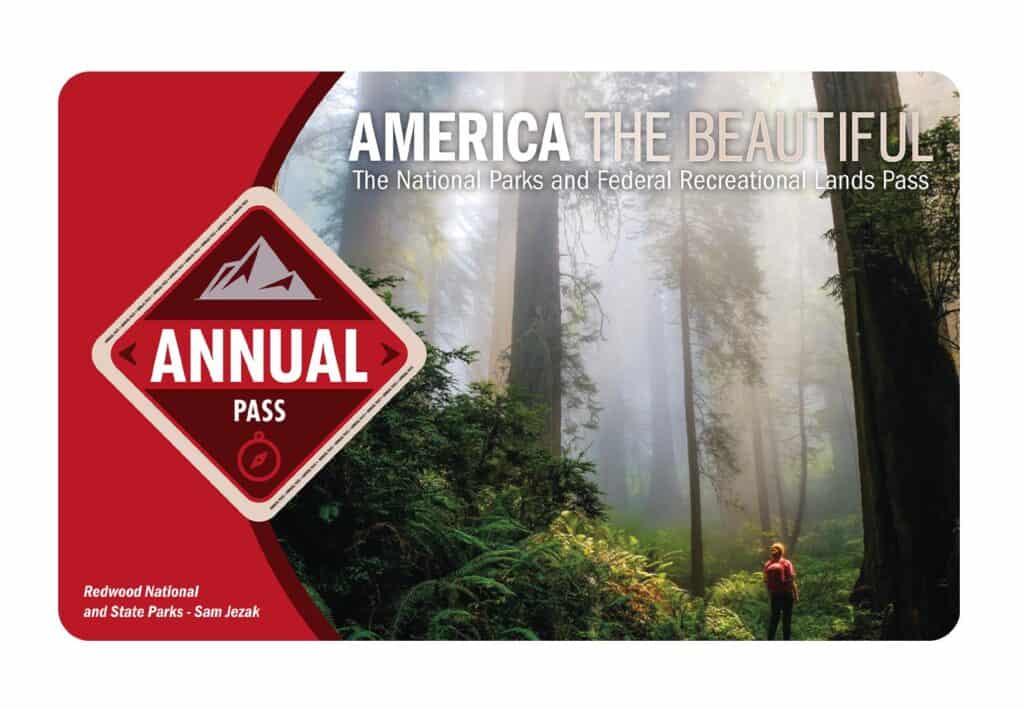
It costs $80 for a yearly America the Beautiful Pass. This gives you access to all national parks and federal areas that charge fees. The America the Beautiful Pass is well worth it!
I purchased my first one in 2016 and it’s such a money-saver! Plus 10% of sale proceeds go to the National Park Foundation.
Tips for Visiting Grand Teton National Park
Grand Canyon National Park is perfect for outdoor enthusiasts. There is something for everyone on this list and for different fitness levels. Also, note that it is dry and hot (in the summer), and make sure you know what you are getting into before you start. Here are a few tips for visiting the Grand Canyon:
- Bring a reusable water bottle and lots of water! Remember you are in the sun and you will need to drink lots of water. I love my LifeStraw Filtered Water Bottle. I can refill this bottle anywhere and it comes with a carabiner to connect it to my daypack.
- Check the Weather – days over 100 degrees are very common. Make sure to check.
- Hiking boots or sandals that will protect your feet! I love good shoes. I need all the support and help I can get. I actually love these sandals for hiking and also love these hiking boots.
- Bring hiking poles for balance and to protect your knees. I know many experienced hikers (and even amateur ones) think that hiking poles are for old people who lose their balance. Actually, hiking poles can help when going down steep inclines or when scrambling over rocks. They are great to hike with even for the most experienced hiker.
- Wear a sunhat. I feel like this whole post is about how high you are in the mountains and how much closer you are to the sun but it is so true. At elevation, you are closer to the sun and more likely to burn. Wear sun protection such as a sun hat and sunscreen.
- Be aware of the wildlife. This is the Southwest and you will need to watch out for snakes and other wildlife such as moose or a bear. Please stay away from wildlife and do not feed them. I recommend carrying bear spray as well.
- Start Early – If you want to avoid the traffic and the heat you will need to start your hike early. That way it will be nice and cool and the smog will not affect you either.
- Leave no trace. If you are new to the concept of Leave No Trace it is all about preserving the environment to ensure it is in the same or better condition when you leave it. This means that you should stick to the trails and carry out everything that you carried in. This is a great explanation of the Leave No Trace principles!
- Water shoes are great for water hikes– If you don’t have a pair, I highly suggest it as they are affordable. I have an article on the pros and cons of several pairs of water shoes.
- Bring Bug Spray and a snack: Be sure to bring everything you need including a snack like a protein bar plus BUG SPRAY.
Where to stay near Grand Canyon National Park
The Grand Canyon makes for a great weekend escape. Fresh air, beautiful scenery and being in nature does a world of good for the soul. I recommend staying as close to the park as possible and even treating yourself with a cabin with a spa pool to relax at night.
- There are lots of fantastic Airbnbs near the Grand Canyon. I have made a list of the best airbnbs around the park wherever you decide to stay. You can also check out my post on Where to Stay near the Grand Canyon to find the perfect hotel for any budget.
If you are taking a road trip remember to reserve a car in advance using Discover Cars .
Weather in Zion National Park in August
In Zion National Park, August is usually very hot. Take at least 3-liters of water with you, especially if you are taking the shuttle bus and may not have access to your car.
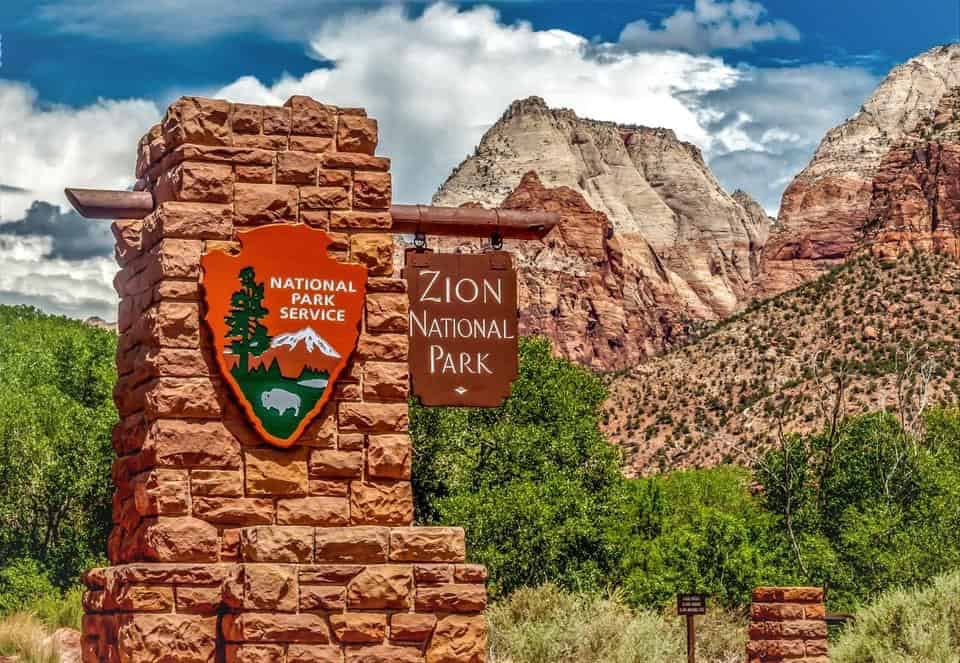
The average temperature in Zion Canyon is 97 degrees Fahrenheit with a low of 66 degrees Fahrenheit. During August, it rains on average 6 days.
The monsoon season in Zion runs from mid-July to mid-September; always check the weather forecast before venturing on a hike, and be aware of the dangers of flash flooding.
Tips for Visiting in Zion National Park
Zion is perfect for outdoor enthusiasts. There is something for everyone on this list and for different fitness levels. Also, note that it is dry and hot (in the summer), and make sure you know what you are getting into before you start. Here are a few tips for visiting Zion:
- Bring a reusable water bottle and lots of water! Remember you are in the sun and you will need to drink lots of water. I love my LifeStraw Filtered Water Bottle. I can refill this bottle anywhere and it comes with a carabiner to connect it to my daypack.
- Check the Weather – days over 100 degrees are very common. Make sure to check.
- Hiking boots or sandals that will protect your feet! I love good shoes. I need all the support and help I can get. I actually love these sandals for hiking and also love these hiking boots.
- Bring hiking poles for balance and to protect your knees. I know many experienced hikers (and even amateur ones) think that hiking poles are for old people who lose their balance. Actually, hiking poles can help when going down steep inclines or when scrambling over rocks. They are great to hike with even for the most experienced hiker.
- Wear a sunhat. I feel like this whole post is about how high you are in the mountains and how much closer you are to the sun but it is so true. At elevation, you are closer to the sun and more likely to burn. Wear sun protection such as a sun hat and sunscreen.
- Be aware of the wildlife. This is the Southwest and you will need to watch out for snakes and other wildlife such as moose or a bear. Please stay away from wildlife and do not feed them. I recommend carrying bear spray as well.
- Start Early – If you want to avoid the traffic and the heat you will need to start your hike early. That way it will be nice and cool and the smog will not affect you either.
- Leave no trace. If you are new to the concept of Leave No Trace it is all about preserving the environment to ensure it is in the same or better condition when you leave it. This means that you should stick to the trails and carry out everything that you carried in. This is a great explanation of the Leave No Trace principles!
- Water shoes are great for water hikes– If you don’t have a pair, I highly suggest it as they are affordable. I have an article on the pros and cons of several pairs of water shoes.
- Bring Bug Spray and a snack: Be sure to bring everything you need including a snack like a protein bar plus BUG SPRAY.
Visiting Zion National Park in August – What to Do and See
Zion Canyon Scenic Drive
Zion Canyon is the most spectacular part of Zion National Park. The Zion Canyon Scenic Drive, an in-and-out route that runs down the canyon floor with high sheer walls on both sides, is the only way to get into the canyon.
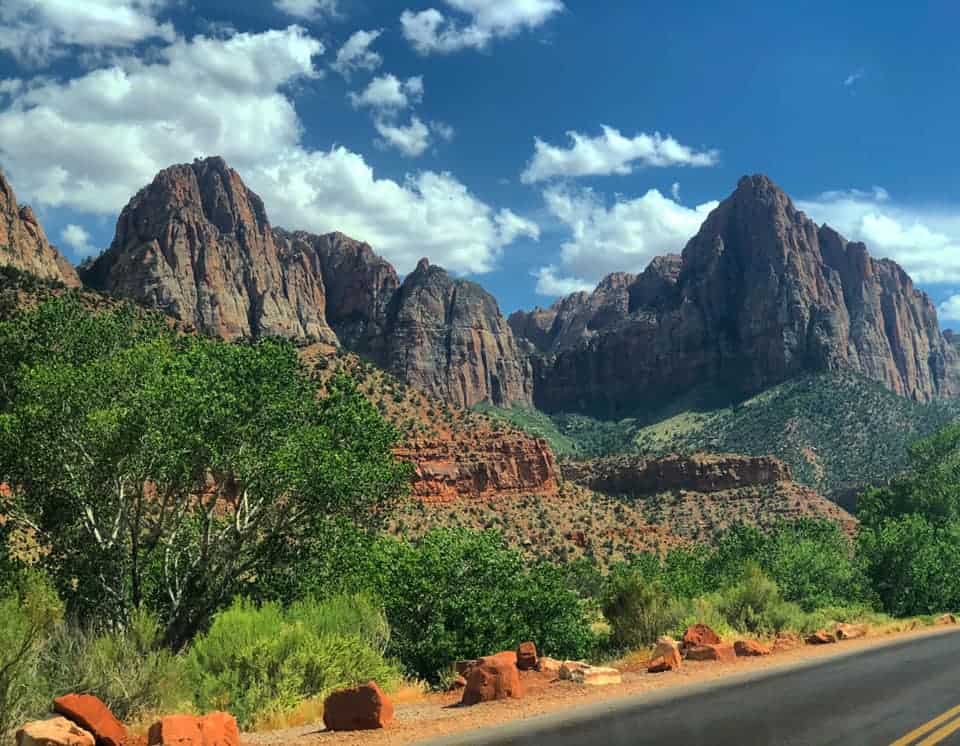
The park’s shuttle bus, which stops at picturesque locations and hiking trailheads along the way, is a convenient method to get around this area. Bicycle racks are available on shuttle buses. You can travel this route in your vehicle during the winter when the shuttle bus is not operating.
This route provides views of some of the park’s most well-known attractions, including a lookup to Angels Landing. The road comes to an end at the start of the Narrows, one of the park’s most famous attractions. Along the road, you’ll find the majority of the park’s major attractions.
Drive the Zion-Mount Carmel Highway
The Zion-Mount Carmel Highway, which runs from the South Entrance to the East, is perhaps as beautiful as the Zion Canyon Scenic Drive, but it offers a completely different perspective as it winds high above the valley providing stunning vistas from one side to the other.
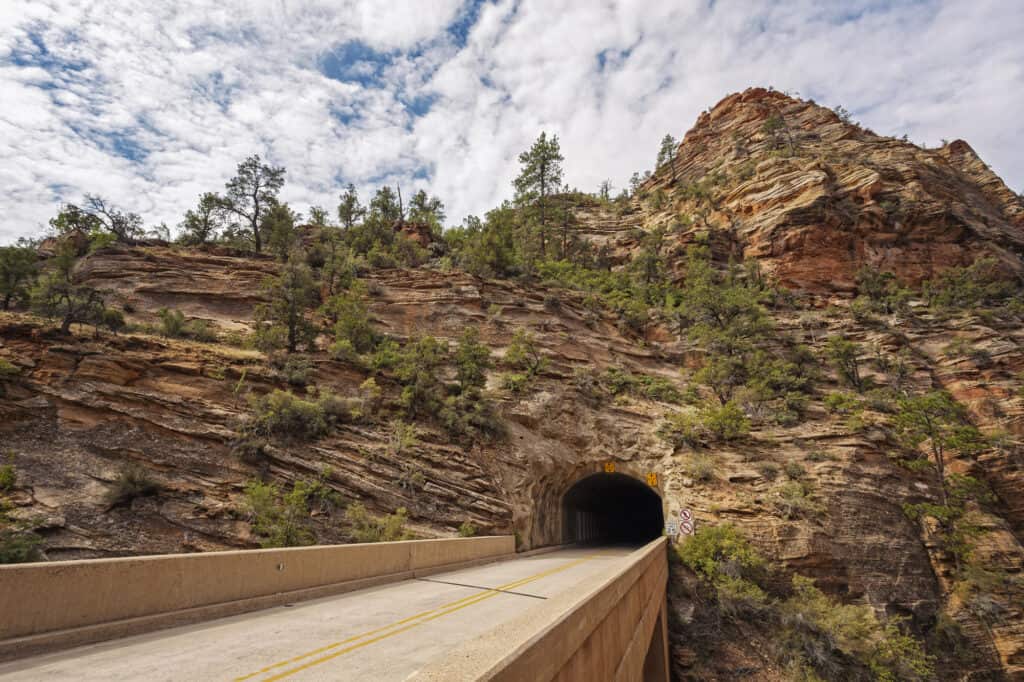
As it rises the mountainside, the road follows the rock wall. The road runs via a narrow 1.1-mile tunnel after a steep ascent. Since the tunnel is too narrow for RVs to pass through, traffic is diverted in one way when RVs enter the tunnel. To pass through the tunnel, RV drivers must pay a fee when they enter the park, and a pass must be obtained in advance before you and your RV may proceed.
This section of the park is higher, cooler, and home to a few huge pine trees. Along this road, numerous roadside pullouts provide convenient observation sites. This route is not operated by the shuttle.
Kolob Canyon
A day in the northwestern Kolob Canyon is ideal for visitors looking to get away from the crowds in Zion Canyon.
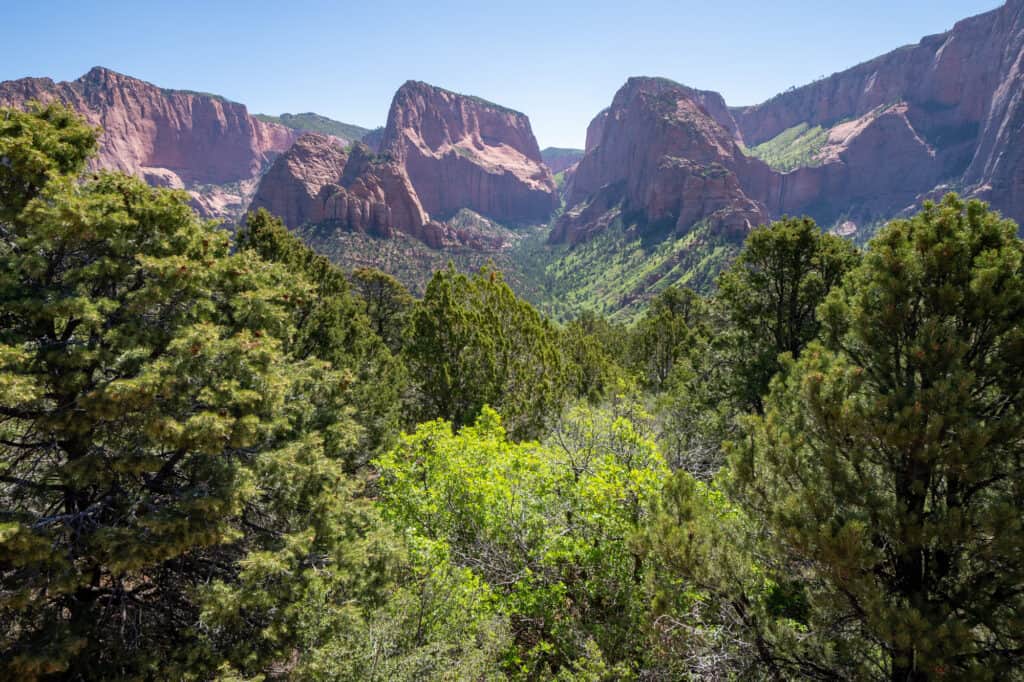
The Kolob Canyon, located 17 miles south of Cedar City, Utah, is known for their beauty and tranquility. It’s easy to see why this portion of the park was named Kolob, which means “dwelling nearest to heaven” in Mormon scripture.
Visitors are treated to beautiful desert canyons, cascading waterfalls, and Navajo sandstone summits. You can drive along the 5-mile-long Kolobs Canyon Road to take in the sights, arrange a hike, or do both while you’re here. Three out-and-back trails, ranging in length from 1 to 14 miles, are accessible.
Recent visitors to this section of the park raved about how much fun they had. Travelers were relieved to discover that the Kolob Canyon had far less foot traffic than Zion Canyon, and some even thought it was more beautiful.
The vista from this mile-long trail is so expansive that hikers may be able to see for up to 100 miles. Kolob Canyon is not accessible from the park’s main entrance; instead, you must enter from the park’s west entrance.
Hiking in Zion National Park in August
Angels Landing
The Angels Landing trail leads to an elevated vantage point, as its name suggests. During the 5.4-mile round-trip climb, hikers will rise 1,488 feet, with some sheer cliffs and steep slopes that may be mentally demanding for individuals who are afraid of heights.
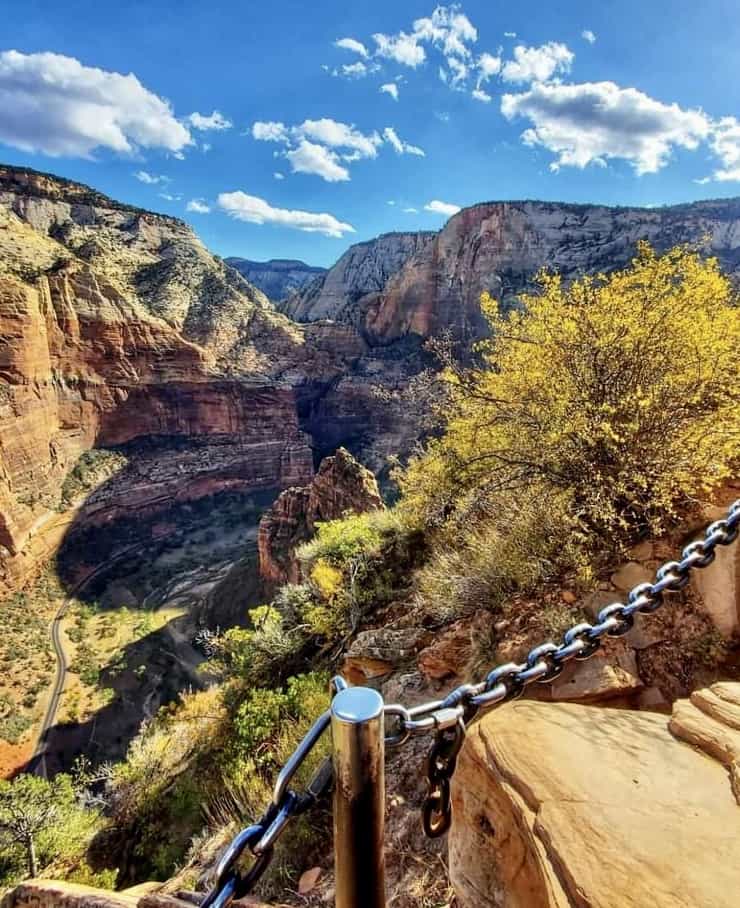
Hikers should turn back at Scout Lookout (which also has restrooms), as the final section of the trail to the landing requires gripping chains to retain your footing on the precipitous drop-offs and also a permit.
Angels Landing trailhead is located in the Grotto Picnic Area in Zion Canyon, and it is most popular in the summer. The trail can be dangerous in the winter due to icy conditions, and it can be hot in summer.
If you’re hiking in the summer, start early to avoid the heat of the midday sun. At the trailhead, there are facilities; hikers should bring water and snacks in a backpack so that they can hold the chains with their free hands on the last ascent. Angels Landing is accessible through the park’s free shuttle and is included with park admission.
This is a tough hour-long hike that is not suitable for children or anyone with a fear of heights. Since the path gets packed on weekends, take the hike during the week.
Lower Emerald Pools
A weeping wall and pools can be placed at the base of Lower Emerald Pools. A.6-mile round-trip paved trail leading from the Zion Lodge shuttle bus stop #5 leads to the site.
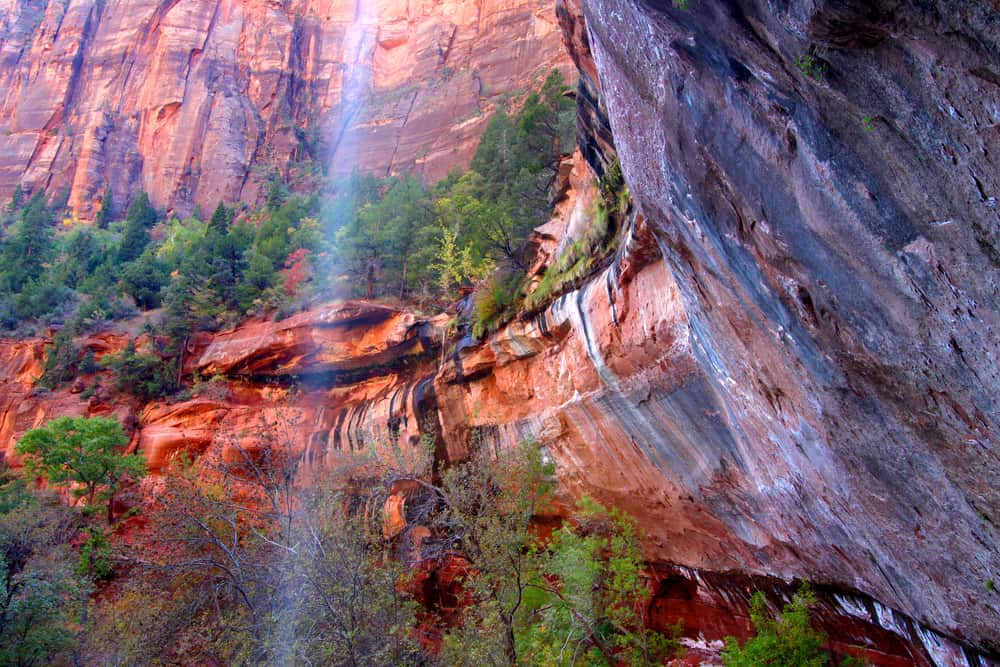
The foliage thickens in less than half a mile (1.5 mi), and the trail winds its way through a steep alcove beneath two tall waterfalls and the pools below. This location is easily accessible to the elderly and parents with strollers.
This is a particularly nice walk in the spring when the leaves are out and water is flowing over the wall. If you have more time and energy, you can continue beyond this point, walking behind the falls, to the Middle and Upper Emerald Pools.
Weeping Rock
Weeping Rock is a popular tourist attraction along the Zion Canyon Scenic Drive. The hanging gardens that cling to the otherwise sheer cliffside are visible through this dripping stone overhang.
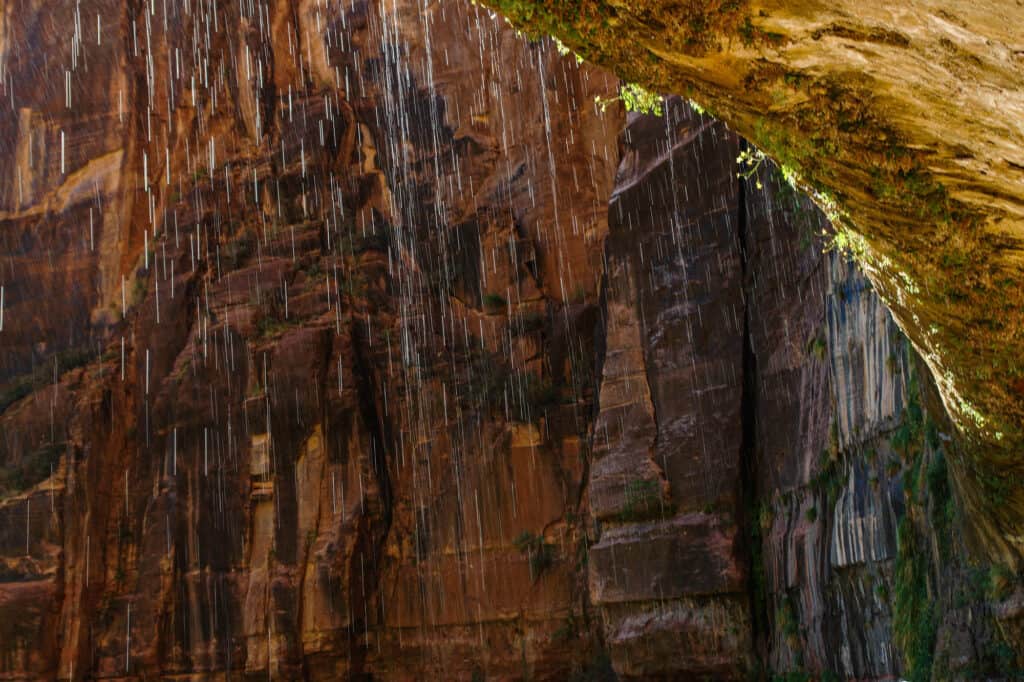
The amount of water coming from the rock varies depending on the season, and it can be drips, a stream, or a full waterfall. Standing at the base of Weeping Rock provides a unique perspective of the valley as well as a sense of the canyon walls’ enormity.
Canyon Overlook Trail
Canyon Overlook Trail is one of the easiest and most photographed trails in Zion National Park, but also one of the busiest.
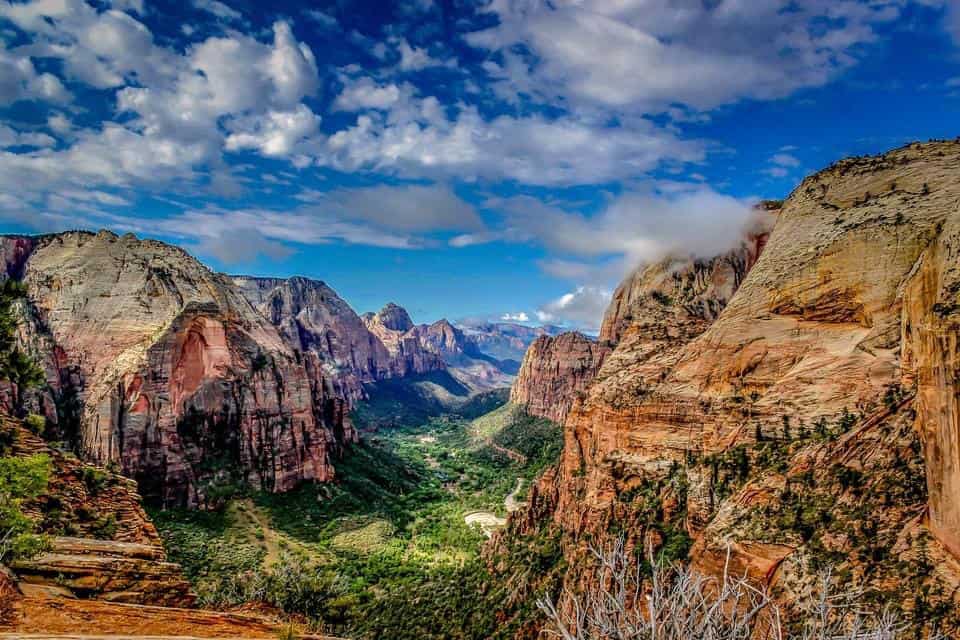
This trail is only a mile round trip and takes hikers 100 feet from the parking lot to the overlook, where they may enjoy spectacular views of Zion Canyon.
Due to restricted on-site parking, most visitors recommend starting your hike early. Despite the trail’s short length, it contains some narrow, rocky areas that may be difficult for young children to navigate.
To get to the trailhead, take Highway 9 to the Mount Carmel Tunnel’s east entrance. You can park your car on the south side of the road and walk up to the trail on the north side. It’s worth noting that the park’s shuttle service does not stop here.
Observation Point
You’ll be at an elevation of 6,521 feet atop Mount Baldy when you reach the summit of the Observation Point path, with a bird’s-eye view of nearly all of Zion National Park’s top attractions.
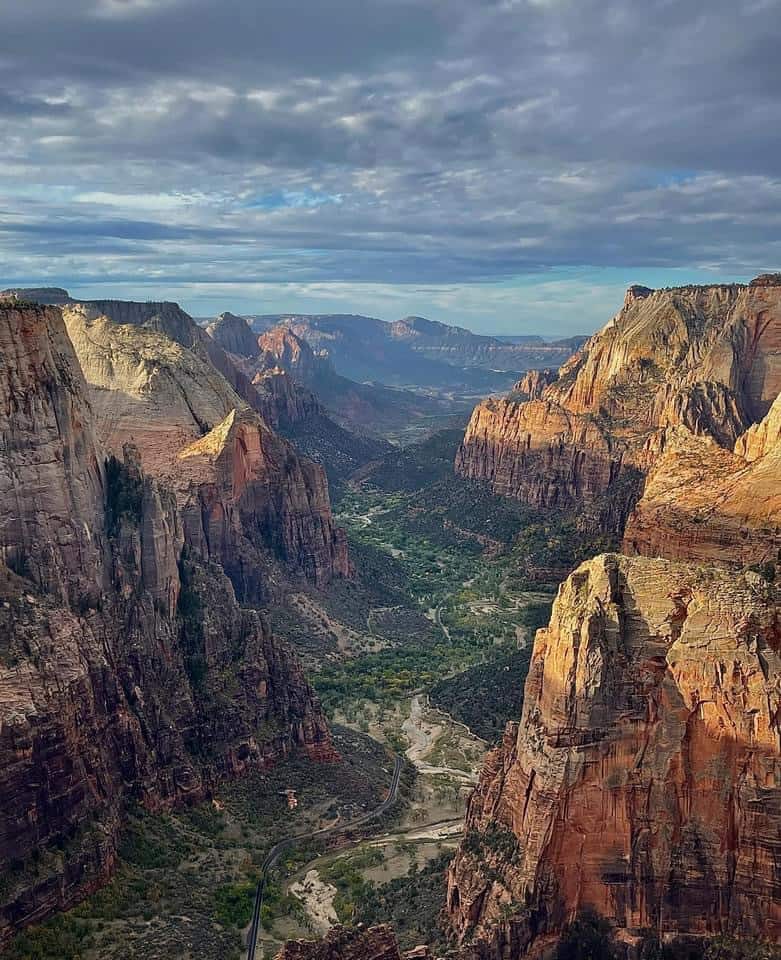
This 8-mile round-trip adventure is not for the faint of heart because hikers will gain 2,000 feet. Wear sunscreen and carry lots of water because some of the treks will be in direct sunlight.
Travelers can take the park’s free shuttle to the No. 7 Weeping Rock stop to get to Observation Point’s trailhead. The East Rim Trail will then be followed until you reach the summit. Visitors will be charged a weekly fee of $35 per vehicle or $20 per person on foot or bike, similar to other attractions inside Zion National Park.
To prevent high heat, get to the trail early and pace yourself for the strenuous uphill trek and return descent. Bringing a packed lunch is also a good idea, as the trek will most likely take several hours.
The Narrows
The Narrows is the narrowest stretch of Zion Canyon and one of the park’s most popular hikes. To experience it, set out from the Temple of Sinawava along the Riverside Walk for a one-mile, wheelchair-accessible hike that offers a good view of The Narrows.
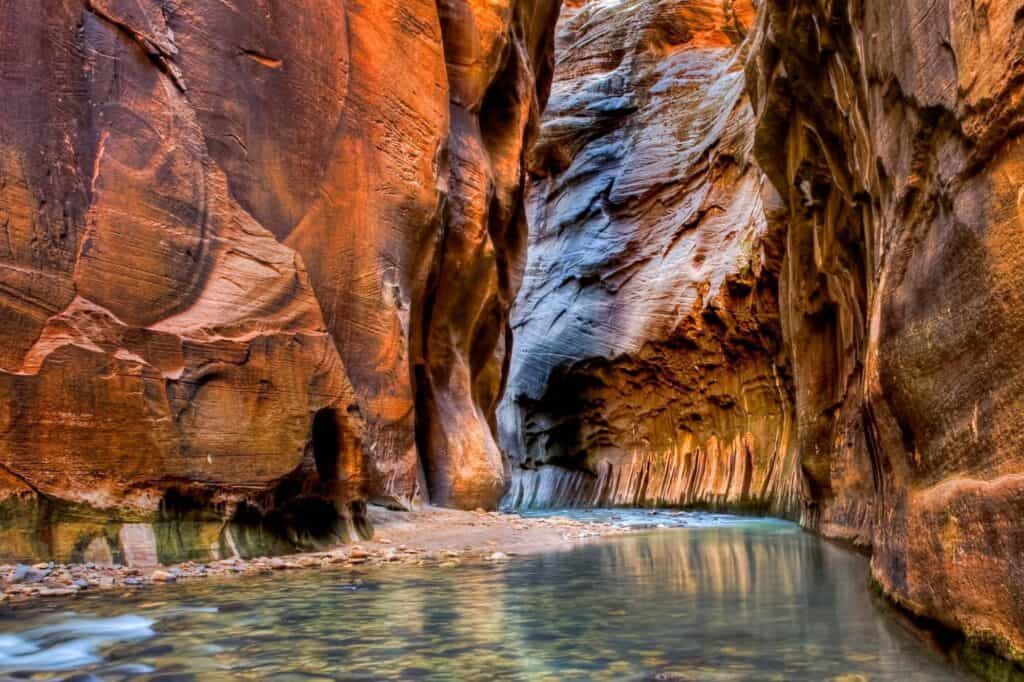
Since the walkway goes into the Virgin River, you’ll have to wade or perhaps swim upstream if you want to go any further. You’ll get awe-inspiring views of the striated, orange-red canyon along the way.
Since the water can reach as high as your waist in certain spots, keep your belongings in a waterproof bag. You’ll also need a hiking stick and waterproof shoes because the rocky, slick terrain is hard to navigate barefoot. It’s also a great idea to get at The Narrows early to escape the crowds.
Many visitors take a 10-mile round-trip hike upstream from the Temple of Sinawava to Big Stream, which does not require a permit.
However, you’ll need a permit to hike 16 miles downstream from Chamberlain’s Ranch. The Narrows is free to visit with your park admission fee, and there are no established hours of operation.
East Rim Trails
The East Rim Trail is perfect for a long day hike or a relaxing backpacking trip. Hikers can either begin their adventure at the Observation Point trailhead and ascend roughly 2000 feet to the plateau’s summit, or they can work their way at the east gate of Zion National Park and descend into the canyon. You’ll be rewarded with breathtaking views of Zion Canyon and Echo Canyon’s surreal coliseum in either case.

The trail levels off beyond the gulch and heads northwest through a sparse ponderosa pine forest on a high mesa. At Stave Spring, the midway mark, water runs intermittently from a pipe. Just past the spring, there is a trail junction.
The East Entrance Trailhead has a shorter elevation gain to the top of the mesa, and the final stretch is all downhill. Using a Springdale guide service, arrange for a shuttle to drop you off at the trailhead, and then take the free Zion shuttle back to the visitor center.
La Verkin Creek
The most popular use of the trail is a challenging and rewarding in-and-out hike to see the Kolob Arch.
Because of the trail’s numerous campsites, longer treks to Willis Creek and the Kolob Section’s lonely northeast portion are also conceivable. The famous Trans-Zion Trek, which extends from the Kolob Canyons to the park’s East Entrance, includes the La Verkin Creek Trail.
The trail starts at Lee Pass and proceeds along Timber Creek, passing by the nearby cliffs’ open narrow canyons. After coming around the corner and within view of La Verkin Creek, the trail descends the slope on a hard-packed track to the creek’s bottom.
This is a fantastic place to spend a few days. Spring, summer, and fall are the best times to hike this trail. The trail is generally covered in snow during the winter, which might continue until early spring. Camping is also only permitted in designated places.
Wildcat Canyon
The Wildcat Canyon Trail connects the Wildcat Canyon Trailhead with the West Rim Trail (just beyond Lava Point) and is part of the Trans-Zion Trek, which permits campers to hike from the Kolob section down to the main canyon.
As it weaves through the ponderosa pine forest, this trail begins at Wildcat Trailhead and continues past the Northgate Peaks Trail junction, providing views of the Northgate Peaks.
It opens up into meadows before reaching the rim of Wildcat Canyon, where it offers sweeping views down into the canyon’s depths. The trail climbs slightly after crossing the canyon until it meets up with the West Rim Trail.
Views stretch across the canyon, with some steep drop-offs and the possibility of rockslides. Basaltic rock, remnants of lava that seeped from rifts and small cones produced when the earth’s crust weakened and stretched, is strewn throughout the upper slopes.
You’ll arrive at the canyon’s entrance (4.25 miles; 7,050 feet) and cross Blue Creek on a shaky log bridge; once across, the trail curves sharply south and begins a meandering climb away from the canyon rim.
This shift to higher elevations is filled with a more diverse ecosystem of yucca, cacti, manzanita, juniper, ponderosa, fir, and spruce.
Although this area does not have any permanent campsites, overnight trips do require a permit.
Hop Valley
In a beautiful, underrated region of Zion National Park, the Hop Valley Trail offers excellent hiking and backpacking opportunities.
Hop Valley is located between Kolob Terrance and Kolob Canyons, at an elevation of 6,000 feet (1,800 meters), making it cooler and more enjoyable during the hot summer months.
The trail starts near Kolob Terrace Road and winds its way across open fields with panoramic views of the surrounding rock formations.
As you get closer to Hop Valley, the trail begins to descend. Hop Valley’s valley floor is stunning, with its flat sandy bottom and steep walls on all sides. The trail is sand-covered and well-worn. Before the steep slope into La Verkin Creek, the campsites are at the far end of the valley.
In the summer, when the crowds and temperatures in Zion Canyon are at their peak, higher, cooler Hop Valley offers a welcome break. In the spring, the trail is ablaze with wildflowers, and in the fall, the trail is illuminated by gorgeous leaves.
Hop Valley is a fantastic day hike. You can also backpack and camp if you want to spend more time exploring neighboring landmarks, such as Kolob Arch, Zion’s largest rock arch.
The Pa’rus Trail
Pa’rus Trail is perhaps the easiest 3.5-mile hike in Zion National Park, thanks to its wide paved trail. It’s also a great way to go to different parts of the park, such as campgrounds and park offices, without having to rely on the shuttle, which can get rather crowded in the summer.
Furthermore, the views of the “bubbling, tumbling waters” of the Virgin River, from which it gets its Paiute name, are breathtaking.
The trailhead is located near the park’s tollbooth on the south end of the park, on the north side of the parking lot. From the trail, you can take a leisurely stroll to the intersection of Highway 9 and Floor of the Valley Road.
Pa’rus Trail is suitable for strollers, bicycles, and wheelchairs, and it is one of the few sites where leashed dogs are permitted. Moreover, the trail’s stunning bridges that straddle the Virgin River are among its best features.
Camping
Spending a night under the stars while gazing at the canyon walls of Zion National Park is an unforgettable experience.
Outside the park gate, there are campgrounds, but camping within the park is a very other experience. Birds and fauna flitting around the campgrounds, sitting around a fire ring after dark in the evening, and staring up at the night sky generate a distinct set of memories than simply visiting Zion by day.
The park’s two main camping locations, Watchman Campground and South Campground, both offer stunning natural surroundings and well-spaced sites. These two campgrounds are close to each other, at the park’s West Gate entrance. This location is very close to Springdale, so you can quickly go into town for whichever you need.
At over 8,000 feet, a third, much smaller and more secluded campground is located in a separate portion of the park. On Kolob Terrace Road, about 50 minutes from the Zion Canyon part of the park, lies Lava Point Campground.
Recent Posts
15 Tips for Visiting the Grand Canyon in September – 2023 Ultimate Guide
Visiting the Grand Canyon in September is a great time to visit. September is a busy time to visit but the crowds are starting to arrive especially toward the end of the month. I’ve included...
15 Tips for Visiting the Grand Canyon in August – 2023 Ultimate Guide
Visiting the Grand Canyon in August is a great time to visit. August is a busy time to visit but the crowds are starting to arrive especially toward the end of the month. I’ve included all...
